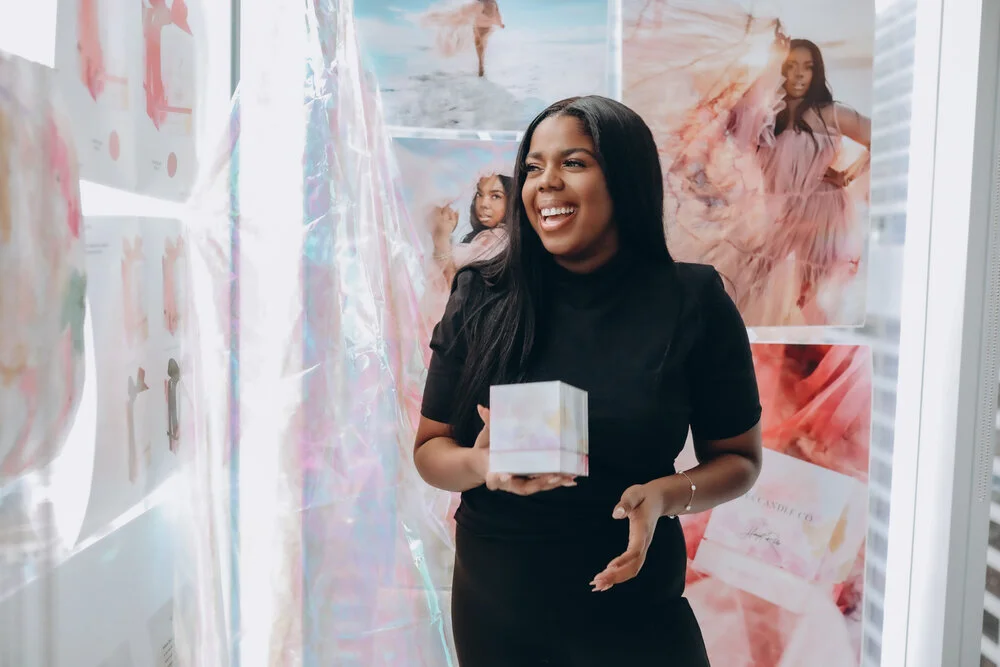Do you have a certain name for your followers, such as “posse,” “magic makers,” or “Insiders?” Do you love shortening the word “business” to the ever-so punchier “biz?” How about insisting your checkout page says “add to bag” over “add to cart?” If you’ve answered yes to any of these, you already have the makings of a verbal identity—aka brand voice. But if that's not you and you're looking to define your brand voice, don't fret!
So what is a brand voice and why does it matter?
A brand voice is how your personality is shown through language. It encompasses everything from your words to your tone, to even your grammar. Everyone has a personality online, and most entrepreneurs have a sound that’s based on their voice. But whether that’s a clear, conscious personality is a different story.
Developing brand recognition requires consistency and repetition to establish trust. So if your personality or messaging changes often, it’ll be difficult for your audience to know what you stand for.
At the end of the day, your customers want to connect with you on an emotional level—85 percent of people buy from companies they have a strong emotional connection with—so having a strong sense of self in your brand helps attract the right people to you, and plays an important role in cutting through all the noise out there. Whether you’re looking to create a memorable brand from scratch or gearing up to finally scale your content, here are four simple steps to flesh out a brand voice your audience will love, and one that feels authentic to you.
1. Use the W.I.L.D framework
This is the exact framework I use when documenting a client’s brand voice for them. Use it as a lens through which you’ll review your writing.
W - Words: The lingo, vocabulary, and terminology for everything, from your regional slang to how to call out your most coveted product.
I - -isms: Your quirks, traits, and all the little things that make you, such as your fav emoji, your favorite phrase, how much you mention your dog, and more.
L - Length: The rhythm of the sentences, such as a long, languid flow or choppy and to-the-point writing (or something in-between).
D - Delivery: The tone of your writing, as in excitable and filled with exclamation points, curious and always asking questions, or even rebellious and breaking all the grammar rules for emphasis.
2. Survey your audience
When you’re a one-person show, it can be tough to take a good, hard look at your style. In that case, turn to your audience. Simply send them a survey or post on your Stories to ask the following:
In one word, how would you describe our brand?
If our company were a person, who would it be?
In addition to or in place of their direct input, try auditing your high-performing content. Whether it’s an email to your list or even a podcast episode, your popular and successful pieces can provide insights into the messages and voice your audience likes best.
3. Look at competitors
If you’re brand new with no data to help you, or you’re feeling stuck and dont know where to start, ask yourself: “What don’t we want our brand voice to be?” Looking at others in your field, was there something that sparked you to start your own business? Is everyone saying the same things, and you know you were born to stand out? Use that fuel to determine how you will write your messages.
4. Document it all
Now that you’ve got the research and brainstorming section done, it’s time to distill that information into your brand voice DNA.
Besides price, voice is typically the number-one reason entrepreneurs don’t, or feel like they can't, hire a copywriter to handle their writing. So have an in-depth, well-defined brand voice and style guide to ensure whoever you hire gets your voice just right. That'll give you time to focus on what you do best. Here's some of the details you should include:
A personality type
This can provide an overarching sense of how you show up online. Are you the momma bear who’s fiercely protective of her tribe? Or are you the Monica Gellar of your industry striving for perfection? Have fun with it!
3–5 voice pillars
According to the adjectives your audience used to describe you, as well as the insights you’ve conducted, simply look for the common threads. Are you bold, savvy, witty, sophisticated, elegant, authentic, flirty, etc? Choose three to five that best describe you.
Changes per channel
As for tone, think: Does your authoritative self come out on Linkedin? Does your brand discuss sensitive or politically-charged topics that you’d want to be more sensitive about on social—but bolder on your email list? List out the channels where you are present, and how the tone may change.
Grammar
If you cringe at a missing serial comma or you’re a mega fan of the interrobang (‽), get it all down on paper. This not only makes your writing consistent and full of personality, but ensures you can cut down on editing time next time you want to hire a writer.
About the author: Kaleena Stroud is a conversion copywriter and brand voice strategist from California. She creates personality packed verbal identities for DTC brands that want to stand out and personal brands that need help defining their brand voice magic. Check out her website for more voice and writing tips or contact her to find out which of the nine voice archetypes YOU are.
This story has been updated.

















